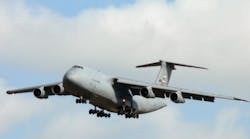F-35 program achieves static structural testing milestone, concluding two years of testing by Lockheed Martin, BAE Systems, Northrop Grumman, Joint Program Office engineers
FORT WORTH, Texas, 20 Sept. 2011. Engineers at Lockheed Martin, BAE Systems, Northrop Grumman, and the Joint Program Office have concluded more than two years of static structural testing of Lockheed Martin's (NYSE:LMT) F-35, and done so ahead of schedule. Completion of this testing, which helps verify the structural integrity of the airframe, marks the achievement of one of five milestones established by the Joint Program Office for 2011. The process also helps to ensure specifications outlined in technical drawings that were used to produce the aircraft are accurate, as well as employs simulation techniques and tools. External loads designed to mimic the pressures of full envelope flight conditions are applied to hundreds of points on the airframe using an integrated system of load pads, hydraulic actuators, air pressurization mechanisms and reaction channels.
Engineers tested the structure to 115 percent of requirements and confirmed that no detrimental deformation of the structure occurred, providing evidence that the airframe is capable of withstanding the pressures associated with the full flight envelope. In the final phase of testing, the airframe was further pushed--to 150 percent of requirements to verify that no rupturing or structural failure occurred.
"As one of our major program milestones, the completion of static structural testing demonstrates the significant progress that we're making on our joint mission to field this 5th Generation air combat capability," explains Larry Lawson, executive vice president and general manager of the F-35 program. "These successful tests bring us one step closer to delivering the F-35 into the hands of the men and women of our U.S. and allied forces."
The F-35 Lightning II, a 5th Generation fighter, combines advanced stealth with fighter speed and agility, fused sensor information, network-enabled operations, advanced sustainment, and lower operational and support costs.
Lockheed Martin engineers are developing the F-35 with Northrop Grumman and BAE Systems.
